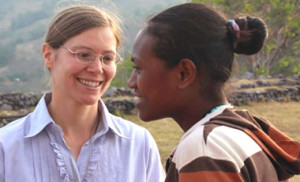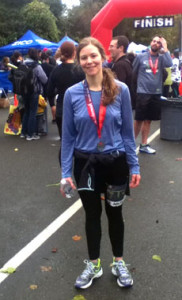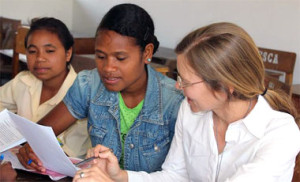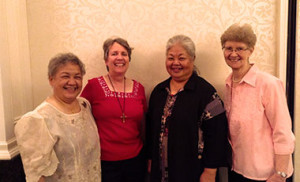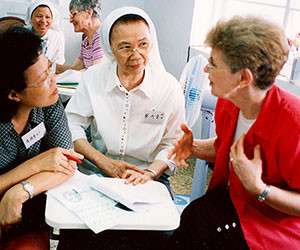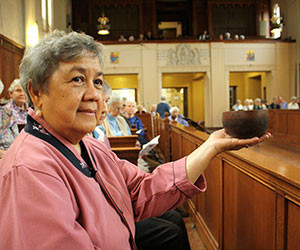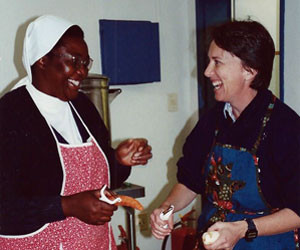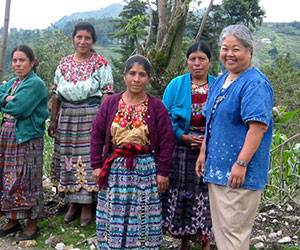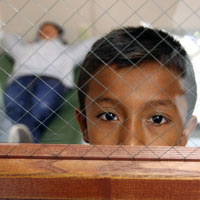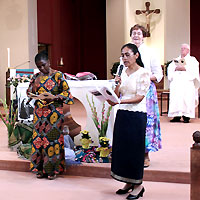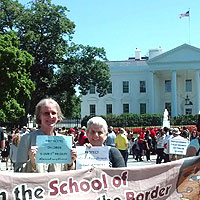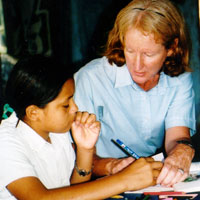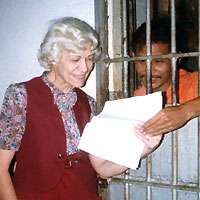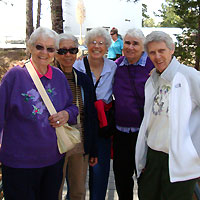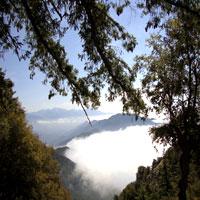By Mary Ellen Manz, M.M.
From Maryknoll Magazine: When Susan Wanzagi took her first vows as a Maryknoll Sister last August, her vocation journey came full circle—back to her baptism in Tanzania. Presiding at the Mass for Sister Wanzagi’s profession was the very same priest who baptized her 30 years earlier: Father Edward Dougherty, superior general of the Maryknoll Fathers and Brothers for the last six years.
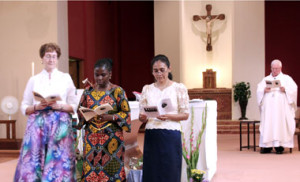 While neither remembers the exact celebration of the sacrament, their entwining paths seem like, … well, providence.
While neither remembers the exact celebration of the sacrament, their entwining paths seem like, … well, providence.Recently in Africa for a meeting of the Maryknoll Fathers and Brothers serving there, Father Dougherty learned that two young Tanzanians had expressed interest in joining the Maryknoll Sisters. “The missioners were excited, exclaiming that ‘two of our girls’ from Musoma are going to be Maryknoll missioners,” says Father Dougherty, who served in the Musoma Diocese of Tanzania from 1976 to 1986.
A short time later, when he was visiting Chicago, he met another future Maryknoll Sister from Tanzania, Susan Wanzagi, who comes from the Zanaki parish where he had served. She was in her canonical year—the last stage of preparation before taking her first vows as a Sister.
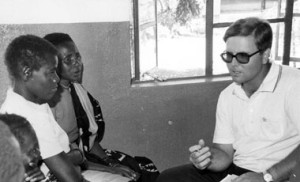
Both had to admit they didn’t remember each other. Father Dougherty says he and the four other Maryknoll missioners then working in Zanaki spent most of their time visiting mission stations in the African bush, where they ministered to thousands of people.
“It was my first parish after ordination. I loved that mission,” says Father Dougherty. “It was huge, taking in at least 50 villages. That area was later divided into four or five parishes.”
It was Sister Wanzagi’s mother, Joyce, who had remembered him.
Sister Wanzagi says she owes her faith and vocation to her mother’s desire to provide her nine children with a solid religious upbringing. Peter Wanzagi, the new Sister’s late father, was a Catholic and her mother was a member of the Anglican Church. But Maryknoll Sisters had taught both of Sister Wanzagi’s parents and her mother decided to become a Catholic so the family could worship together. Susan’s mother was received into the Catholic Church and four of her children were baptized in the Zanaki parish in 1984.
“When I was young, I felt that I would like to be a religious Sister,” Sister Wanzagi says. “But then I was busy studying in schools away from home and the thought left me for a while.” One day in 1999, Maryknoll Sister Connie Krautkremer visited Susan’s high school and spoke about the missionary work of the Maryknoll Sisters. She invited the students to think about their own lives and what God might be calling them to do. “It was then that I decided to be a Maryknoll Sister,” Sister Wanzagi says.
After finishing secondary school, she went to the University of Dar es Salaam, the capital of Tanzania, earned a bachelor’s degree in education and taught high school while she discerned her calling.
On Jan. 6, 2012—the 100th anniversary of the founding of the Maryknoll Sisters—Susan was welcomed by the Sisters in Tanzania to begin her journey with the congregation by experiencing its prayer life and various ministries, sharing in the household duties and getting to know the Sisters and herself a little better. As she learned about the history and missions of the Maryknoll Sisters throughout the world, she says, “I was very moved to see the suffering of people and it helped to make my choice to be a Maryknoll Sister very strong.”
On Aug. 10 of this year, the spiritual relationship begun 30 years ago at baptism marked a milestone as Father Dougherty presided over the eucharistic celebration at which Susan Wanzagi pronounced her vows in the Maryknoll Sisters Chapel at Maryknoll, N.Y.
“It’s really exciting the way things develop,” Father Dougherty says, alluding to how the Holy Spirit has worked not only in Sister Susan’s life but also in the entire Wanzagi family. Sister Susan’s brother John is a priest for the Musoma Diocese and studying in Rome, and her sister Felista is following in Susan’s footsteps. Felista is in her first year of orientation with the Maryknoll Sisters in Tanzania.
“Mission is continuing through Susan, her brother and her sister and so many others where we served in mission years ago,” Father Dougherty says. “Truly, what goes around comes around and we are privileged to be a part of it.”

